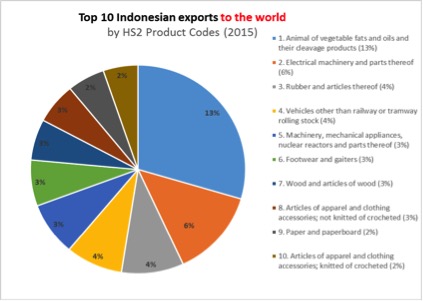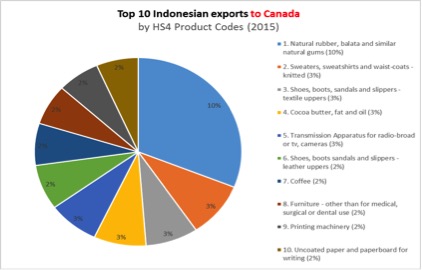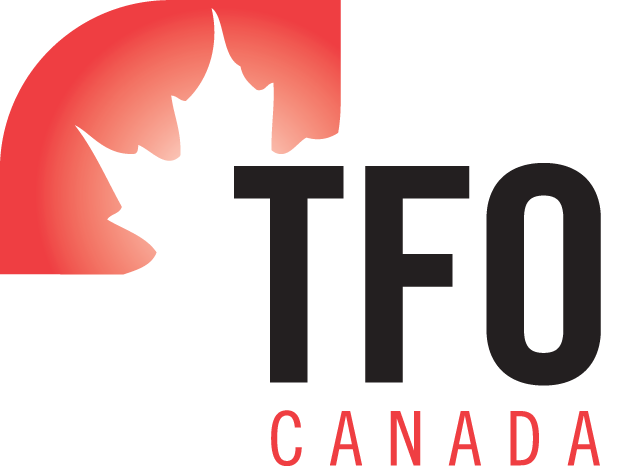Indonesia – Country Profile
General Information
| Official Name | Republic of Indonesia |
| Capital | Jakarta |
| Land Area | 1,904,443 sq km |
| Population | 258.2m (2016; UN) |
| Currency | 1 $CAD = 9,900 rupiah (Indonesian rupiah) |
| National Holiday | August 17 (Independence Day) |
| Language(s) | Indonesian (Bahasa Indonesia), English as well as some 250 other regional languages and dialects |
| Largest Cities | Jakarta (9.6 million), Bandung (3.1 million), Surabaya (2.7 million) |
Source: Economist Intelligence Unit, Bank of Canada (Currency Conversion (08/03/2017)
Political Information
| Form of State | Unitary State |
| Head of State | President Joko Widodo |
| Elections | Last: July 2014; Next: April 2019 |
Source: Economic Intelligence Unit
Economic Information
| Indonesia | Canada | |
| GDP (PPP) | $4.028 trillion | $ 2.191 trillion |
| GDP per capita | $15,772 | $ 60,085 |
| GDP annual growth rate | 4.9% | 1.2% |
| GDP – composition by sector | Agriculture: 38.9%Industry: 13.2%Services: 47.9% | Agriculture:1.6%Industry:27.7%Services:70.7% |
| Inflation rate – average consumer prices | 3.8% | 1.6% |
| Main industries | petroleum and natural gas, textiles, automotive, electrical appliances, apparel, footwear, mining, cement, medical instruments and appliances, handicrafts, chemical fertilizers, plywood, rubber, processed food, jewelry, and tourism | transportation equipment, chemicals, processed and unprocessed minerals, food products, wood and paper products, fish products, petroleum, natural gas |
Note: 2016 data in Canadian dollars ($CAD)
Source: IMF World Economic Outlook, World Bank Data, CIA World Factbook, Bank of Canada (Currency Conversion (08/03/2017).
Political and Economic Stability
With a long history of political turbulence and autocratic rule, Indonesia has benefited from relative peace and stability since its transition to democracy in 1998. In the past years, political stability has been further strengthened by president Joko Widodo’s popularity and his political coalition currently controlling 70% of parliament. While these political shifts have brought along overall progress in the level of political freedom, there remains issues related to endemic corruption, and freedom of expression remains limited by governmental policies. With a recent history of separatism and religious extremism, there are still instances of armed conflict in between government forces and rebel groups in certain provinces such as Papua and Maluku.
On the economic plan, Indonesia is an emerging middle-income country and is currently the largest economy Southeast Asia as well as a member of the G20. The country’s GDP growth was at 4.9% in 2016, with an average of 5% per year, and has had impressive growth in its gross national income in the past 20 years. Factors such as the rise in private consumption, government spending and exports are indicative of its growing economy and influence in the region. Despite this recent economic success, such factors as the decrease in the demand for commodities, fixed investments and domestic consumption has slowed GDP growth during the last years.
In 2016, Indonesia’s exports exceeded expectations, with an increase of 15.8%, with most exports still stemming from its large base of natural resources. The country’s main trade partners are the United States and other Asian countries such as Japan, China and Singapore. With the objective of rebalancing and diversifying its economy, the Indonesian government is focussing on developing its manufacturing sector and other industries to reduce its heavy dependence on commodities. This recent development is further supported by the fact that countries such as China are turning to Indonesia as future destinations for investments in manufacturing. Recent policies have also favoured trade, with the removal of barriers previously imposed on FDI and the lowering of high logistics costs.
Indonesia’s economic growth is also bringing about improvements in terms of social indicators. The country has lowered its poverty rate from half since 1999, and investments in developmental priorities are growing due to a shift in public spending. Being in the third phase of its 20-year developmental plan (2005-2025), Indonesia is currently focussed on improving social assistance programs related to healthcare and education. Despite these improvements, many challenges remain in achieving some of its Millennium Development Goals (MDG). This is especially the case with unemployment, the inequality rate and poverty reduction, with approximately 28 million Indonesians still living under the poverty line and close to 40% of the population is at risk of falling into poverty.
Security
Global Affairs Canada recommends that Canadians travelling in Indonesia exercise a high level of caution due to a continuing threat of terrorist attacks throughout the country. Although there is no nationwide advisory in effect, Global Affairs advises against all non-essential travel to the province of Papua due to an increase in acts of violence. The Public Health Agency of Canada has also recently issued a Travel Health Notice concerning the Zika virus. The Agency recommends that Canadians practice special health precautions while travelling in Vietnam and advises pregnant women and women planning to be to avoid travelling to the country. For detailed and up-to-date information on travel security, please refer to the Global Affairs Canada Travel Report.
Trade Information
| Trade Partners & Direction | 2011 | 2012 | 2013 | 2014 | 2015 | Average Yearly Growth |
| Indonesia to the World ($CAD Million) | 201, 092 | 189,920 | 187,921 | 194,271 | 2,023 | -1% |
| Indonesia to United States ($CAD Million) | 16,302 | 14,901 | 16,204 | 18,2751 | 20,756 | 13% |
| Indonesia to Canada ($CAD Million) | 1,429 | 1,314 | 1,374 | 1,519 | 1,672 | 10% |
| Canadian Exports to Indonesia ($ CAD Million) | 1,641 | 1,681 | 1,908 | 2,023 | 1,812 | -10% |
Note: Data in millions of Canadian dollars ($CAD)
Source: Trade Data Online (Innovations, Science and Economic Development Canada), Trade Map (International Trade Centre), World Integrated Trade Solution (World Bank), United States Trade Representative

Excluding mineral products (HS2 Codes 26-27 and 71-80)
Source: International Trade Centre Trade Map

Excluding mineral products (HS2 Codes 26-27 and 71-80)
Source: Industry Canada Trade Data Online
Business Climate
The World Bank’s annual Doing Business report ranks economies from 1 to 190 (with 1 being the best) on their ease of doing business. In the 2017 report, Indonesia ranked 91 overall and 108 for Trading Across Borders, which measures the ease with which a standardized shipment of goods can be imported or exported across its borders. The average time to ship goods out of Indonesia was higher than the regional average at approximately 13 days, with an average estimated cost of $CAD 1,235 per 20-foot container. To complete the export process, only four forms of documentation are required: Bill of lading, Commercial invoice, Packing list and Customs of declaration.
Although there are many reputable exporters in Indonesia, Canadian importers should be aware that corruption could be an issue when doing business in the country. Indonesia ranked 90 out of 176 in Transparency International’s 2016 Corruption Perceptions Index where 1st place indicates least corrupt. Canadian companies are advised to exercise strict due diligence before working with a company from Indonesia to ensure that it is a bona fide and reputable entity. It is suggested that Canadian importers commission a report by a credit information provider to verify the financial strength of the partner.
Sustainability Initiatives
The Sustainable Palm Oil Initiative (SPO) is an Indonesian public private partnership that seeks to promote the sustainable production of palm oil within the country. Established in 2013, the project is led by the Indonesian Ministry of Agriculture and Forestry in collaboration with the United Nations Development Programme (UNDP) and numerous multinationals. The SPO aims to minimize the negative social and environmental impact of palm oil production by focussing on a series of key objectives. Examples of the project’s goals are the reduction of deforestation, the improvement of land tenure and mediation mechanisms and the strengthening of smallholders to improve sustainable livelihoods and agricultural practices. The SPO programme is set to continue until 2018, and has effectively promoted favorable changes in the palm oil sector over the last years. With the global demand for palm oil gradually rising and Indonesia being world’s largest producer of palm oil, initiatives such as the SPO will prove beneficial to promote sustainable and responsible practices within this growing industry.
With coffee having historically been a key export market for Indonesia, the Java Mountain Coffee is an indigenous social enterprise seeking to bring change to an industry primarily controlled by men. Based in the province of Java, the women-led company is developing coffee products while donating 10% of sales to their Women’s Empowerment Innovation Fund, which will finance two sustainable programs that will seek to further empower female farmers in Java. The first program, which aims to help women farmers in the region in obtaining organic and Fairtrade certification, will ultimately seek to ensure easier market access, provide capacity building activities as well as ensure better and fairer terms of trade for these women. The second program funded through the initiative will be based around the development of a sustainable nursery, which will provide secondary income to women farmers. With an ambitious goal to successfully empower 1 million women farmers by 2021, the company has established key partnerships with certain large multinationals as well as the Indonesian Coffee and Cocoa Research Institute, who will assist in generating revenue, developing strategies and provide technical assistance to develop these programs.
Trade Opportunities
Although Indonesia’s export partners have traditionally been its Asian counterparts such as Japan, China and Singapore, the Indonesian government is currently seeking to explore new markets through trade deals with regions such as the European Union, India and Australia. The country’s main exports are still heavily based on its natural resources, with rubber, minerals, palm oil and coffee still representing the main industries. Although Indonesian exports to Canada have remained modest over the past years, the Indonesian government’s recent focus on developing other export driven industries bodes well for Canadians looking towards future business opportunities with the country. Commodities such as rubber, paper and wood remain the top exports to the Canadian market, while clothing and footwear exports to Canada have gained traction as emerging sectors.
Natural rubber
Rubber has historically been one of Indonesia’s most attractive and profitable natural resources, and the industry remains a key export market to this day. Boasting the largest rubber plantations in the world, Indonesia is currently the second biggest rubber producer and 9th biggest exporter in the world, with exports reaching $7.5 billion CAD in 2015.While most exports go to the United States, which consumes 28% of Indonesia`s rubber exports, other key markets are Japan and China. In 2015, Canada imported $132.6 CAD million of rubber products from Indonesia, and represents the 8th biggest export market for this industry. Some of the main products are pneumatic tires and various raw rubber materials used for construction or manufacturing purposes. Most recently in 2016, with the price for rubber in decline for the past decade, Indonesia came to an agreement with Thailand and Malaysia, other significant producers, to cut down on production to boost rubber prices on the global market.
Coffee
Another popular export market for Indonesia is its coffee industry, with Indonesia being the fourth largest producer in the world. With the value of coffee exports rising 15% in 2015, coffee was a key product for the country during a period in which total exports were declining. Most exports in 2016 went to the US, Japan Germany and Malaysia. Canadian coffee imports from Indonesia effectively totalled $69,389 CAD million, an increase of 33% from 2014, and Indonesia is the biggest coffee exporter to Canada in Asia. Recent government policies will stimulate more interest in the industry by contributing in diversifying their products and exploring more niche markets, thus further promoting some of its renowned specialty coffee products. Some of the industry’s favoured products are its Robusta and Arabica varieties, with the former being the vastly most lucrative. Other specialty kinds are its Luwak, Tojara, Aceh and Mandailing selections.
Emerging sector: Footwear
One key emerging export market for Indonesia is effectively its footwear industry, which represents the country’s 8th most significant global export. The industry has grown tremendously in the past 5 years, and was the fourth biggest worldwide producer of footwear in 2015. The country is also Canada’s fourth biggest export market, with exports having grown by 70% in the past five years. Some of the main products are sandals, leather shoes and various types of waterproof shoes.
This overall growth for this industry is indicative of the growing efforts in developing Indonesia’s manufacturing, with the government setting the development of the industry as a priority by 2021 and industry leaders such as Nike and other companies in Japan and China have also established productions facilities in the country. The industry has thus effectively had steady growth rates every year, and Indonesia is set to benefit from certain regional factors. In fact, Indonesia’s footwear industry will surely benefit from recent closures of factories in China as well as the United States’ exit from the TPP, which will force some of its regional rival, such as Vietnam, to pay more tariffs when exporting to the US. With these favorable conditions set to boost the country’s footwear industry, Canadians will surely look to further explore this emerging sector of Indonesia’s economy.
TFO Canada Export Offers
TFO Canada provides an information service for Canadian importers interested in sourcing products from developing and emerging economies such as Indonesia. This includes practical advice on sourcing from developing country exporters, a customized news bulletin including new leads from Indonesia as they come in, and a searchable database for sourcing new products and suppliers. The chart below provides a rough idea of the number of supplier profiles from Indonesia, available online with contact information through TFO Canada’s searchable Supplier Database.
| Industry Group | No. of Suppliers in TFO Database |
| Food Products and Beverages (including Seafood) | 54 |
| Furniture | 6 |
| Clothing (not including footwear) | 3 |
| Industrial Goods, Machinery, Parts and Raw Materials | 6 |
| Footwear | 3 |
| Home Décor, Giftware and Crafts | 2 |
| Fashion Accessories | 5 |
| Personal Care, Pharmaceuticals and Natural Health Products | 3 |
Upcoming Trade Shows
Construction Indonesia
September, annually
Jakarta International Expo
Industry: Building Materials, Hardware and Handtools
http://constructionindo.com/
Contact Information
Embassy of the Republic of Indonesia in Canada
55 Parkdale Avenue
Ottawa, Ontario
K1Y 1E5
613-724-1100
http://www.indonesia-ottawa.org/
Useful Links
| Indonesian Chamber of Commerce & Industry (KADIN) | www.kadin-indonesia.or.id |
| Indonesia Canada Chamber of Commerce (ICCC) | www.iccwbo.org/Worldwide-Membership/National-Committees/ICC-Indonesia |
| Association of Natural Rubber Producing Countries (ANRPC) | www.anrpc.org |
| Indonesia Rubber Industry Association (GAPKINDO) | www.gapkindo.org/en.html |
| Indonesian Pulp and Paper Association (APKI) | www.indonesiapaper.net/papermillslist/paper-companies-3 |
| Indonesian Footwear Association (APRISINDO) | www.aprisindo.or.id |
| Indonesian Textile Association (API) | www.apidki-jakarta.weebly.com |
| Indonesian Furniture and Handicraft Association (IFHA) | www.amkri.org/en |
| Indonesian Tannery Association | www.indonesiantanners.com |
| Indonesian Electric Manufactures Association | www.appi-electric.co.id/history1.htm |
| The Association of Indonesian Automotive Industries | www.gaikindo.or.id/index.php?option=com_content&task=view&id=342&Itemid=1 |
| Indonesia Ministry of Trade | www.kemendag.go.id |
Links to Cited Documents
| Bank of Canada – Daily Currency Convertor | www.bankofcanada.ca/rates/exchange/daily-converter |
| Canadian Trade Commissioner Service – Country Info | www.tradecommissioner.gc.ca/eng/trade-offices.jsp |
| EDC (Export Development Canada) – Country Profiles | www.edc.ca/EN/Country-Info/Pages/default.aspx |
| Innovations, Science and Economic Development Canada- Trade Data Online | www.ic.gc.ca/eic/site/tdo-dcd.nsf/eng/Home |
| International Trade Centre – Trade Map | www.trademap.org |
| Transparency International – Corruption Perception Index | www.cpi.transparency.org/cpi2013/results |
| World Bank – Doing Business Report | www.doingbusiness.org/rankings |
| World Bank – Open Data | www.data.worldbank.org/country |
| Bank of Canada – Daily Currency Convertor | www.bankofcanada.ca/rates/exchange/daily-converter |
| Canadian Trade Commissioner Service – Country Info | www.tradecommissioner.gc.ca/eng/trade-offices.jsp |
| CIA World Factbook | www.cia.gov/library/publications/the-world-factbook |
| Global Affairs Canada(Trade & Development) – Foreign Relations | www.international.gc.ca/cip-pic/geo.aspx |
| Global Affairs Canada, (Trade & Development) – Travel Reports | www.travel.gc.ca/travelling/advisories |
| EDC (Export Development Canada) – Country Profiles | www.edc.ca/EN/Country-Info/Pages/default.aspx |
